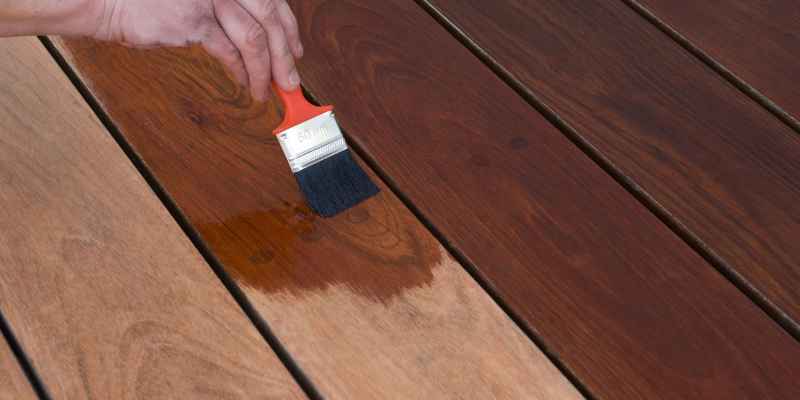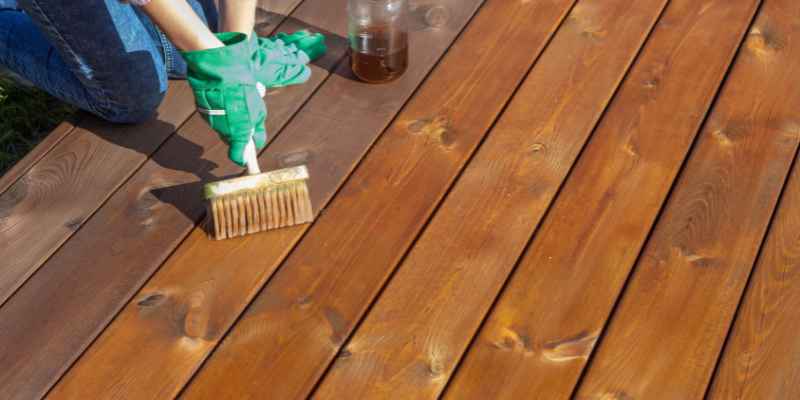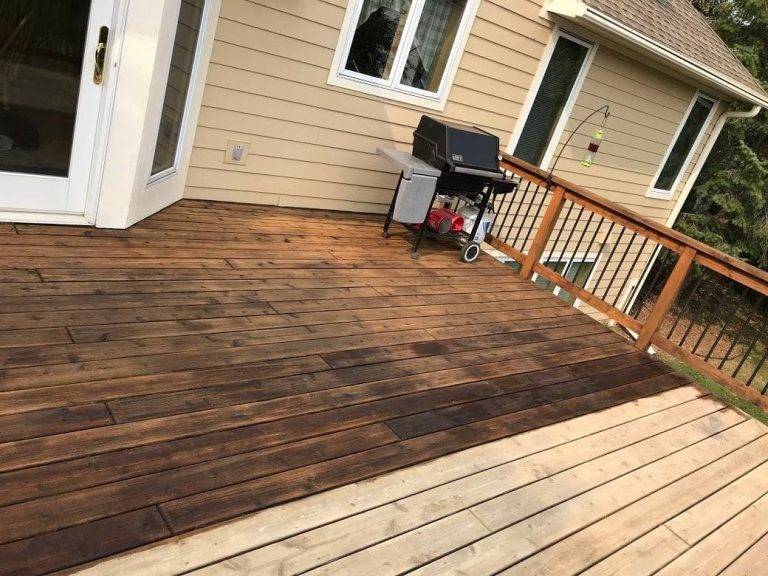Is It Better To Paint Or Stain A Deck: Uncover the Pros and Cons
Painting a deck provides better protection and longevity compared to staining it. A deck is a valuable addition to any home, providing a space to enjoy the outdoors and entertain guests.
However, over time, exposure to the elements can cause a deck to deteriorate. To combat this, homeowners often wonder whether it is better to paint or stain their deck. Both options have their merits, but painting generally offers better protection and longevity.
By creating a protective barrier on the surface of the wood, paint helps shield the deck from sun, rain, and other weather conditions. Additionally, paint allows for more color options and can cover up imperfections or discoloration in the wood. However, it’s important to note that paint tends to require more maintenance and can chip or peel over time. Staining, on the other hand, enhances the natural beauty of the wood and requires less maintenance. Ultimately, the decision between painting or staining a deck depends on personal preference and the specific needs of the deck.
Advantages Of Painting A Deck
Painting a deck offers several advantages compared to staining. It provides better protection against water damage, UV rays, and extreme weather conditions. Additionally, it allows for a wider range of color options to enhance the deck’s appearance.
Enhanced Aesthetics
One of the advantages of painting a deck is the enhanced aesthetics it provides. By painting your deck, you can completely transform its appearance and give it a fresh and vibrant look. Paint comes in a wide range of colors, allowing you to choose a shade that complements the overall design of your outdoor space. Whether you want a bold and statement-making deck or a subtle and elegant one, painting can help you achieve the desired aesthetic. Additionally, paint can cover up any imperfections or flaws in the wood, giving your deck a smooth and polished finish.
Protection Against Uv Rays
Another significant advantage of painting your deck is the protection it offers against harmful UV rays. When exposed to the sun’s UV rays for extended periods, the wood on your deck can start to fade, discolor, or even crack. However, by applying a coat of high-quality paint, you create a protective barrier that shields the deck’s surface from the damaging effects of sunlight. The paint acts as a shield, reflecting a significant amount of UV radiation away from the wood. This not only helps maintain the color and appearance of your deck but also extends its lifespan by preventing sun damage and minimizing the need for repairs.

Disadvantages Of Painting A Deck
While painting a deck may seem like a viable option, there are several disadvantages that you should consider before making your decision. These include peeling and chipping as well as increased maintenance requirements.
Peeling And Chipping
One of the major downsides of painting a deck is the risk of peeling and chipping. Over time, the paint on your deck can start to wear away due to exposure to the elements, foot traffic, and general wear and tear. This can leave your deck looking unsightly and require regular touch-ups to maintain its appearance.
Maintenance Requirements
Painted decks also come with increased maintenance requirements. Unlike staining, which typically only requires reapplication every couple of years, paint requires much more regular upkeep. This includes scraping away any loose or peeling paint, sanding the deck surface, and then repainting it. These additional maintenance tasks can be time-consuming and labor-intensive.
Advantages Of Staining A Deck
Staining a deck offers numerous advantages over painting. It enhances the natural beauty of the wood, provides protection against weather elements, and requires less maintenance in the long run. Stain penetrates the wood, allowing it to breathe and preventing cracking and peeling.
Natural Wood Appearance
Staining your deck offers the advantage of preserving its natural wood appearance for a visually appealing outdoor space. Unlike paint, which covers the wood’s grain, stain penetrates the surface, enhancing the wood’s natural beauty. This allows the textures and patterns of the wood to shine through, giving your deck a warm and organic look.
Easier Application
Staining a deck is a simpler and less time-consuming process compared to painting. The application of stain is generally easier and can be completed with minimal effort. With paint, you need to carefully apply multiple coats to achieve a uniform and solid color, often requiring extensive preparation work. Staining, on the other hand, can be done more quickly and easily, saving you both time and effort.
Protection From The Elements
One of the primary advantages of staining a deck is the protection it provides against the elements. Stain offers a durable barrier that helps to shield the wood from moisture, UV rays, and other environmental factors that can cause damage over time. By protecting your deck from these elements, you can extend its lifespan and save money on costly repairs and replacements.
Enhanced Durability
Staining your deck also helps enhance its durability. The stain soaks into the wood, forming a protective layer that guards against rot, mold, and mildew. This added protection strengthens the deck’s overall structure, making it more resistant to wear and tear. With a stained deck, you can enjoy years of outdoor gatherings and relaxation without worrying about frequent maintenance or premature deterioration.
Wide Range Of Colors And Finishes
When it comes to staining a deck, you have a wide variety of colors and finishes to choose from. Whether you prefer a natural, transparent stain that highlights the wood’s grain or a more opaque, solid color stain that provides a bold statement, there is an option to suit your personal style and preferences. This versatility allows you to customize your deck’s appearance and create the perfect outdoor retreat that reflects your unique taste.
Easy Maintenance
Maintaining a deck that has been stained is considerably easier compared to a painted deck. If your stained deck begins to show signs of wear, a simple touch-up or reapplication of stain can restore its original beauty. On the other hand, paint may start peeling or cracking over time, requiring more extensive preparation and repainting. With stain, you can easily maintain the look and condition of your deck with minimal effort and expense.
In conclusion, staining a deck offers advantages such as preserving its natural wood appearance, easier application, protection from the elements, enhanced durability, a wide range of colors and finishes, and easy maintenance. These benefits make staining a great choice for those looking to enhance the beauty and longevity of their outdoor space.

Disadvantages Of Staining A Deck
Staining a deck can be a popular choice for homeowners looking to enhance the natural beauty of their wood decks. While staining offers some advantages, it’s important to be aware of the potential disadvantages that come along with it. From limited color options to less protection against UV rays, here are some factors to consider when deciding whether to stain your deck.
Limited Color Options
One of the main drawbacks of staining a deck is the limited range of color options available. Unlike paint, which can be customized to any shade, stains typically come in a smaller selection of earthy tones such as brown, red, or gray. This can be a disadvantage for those looking to match their deck with the overall aesthetic of their home or create a more vibrant outdoor space.
Less Protection Against Uv Rays
Another disadvantage of staining a deck is that it provides less protection against harmful UV rays compared to paint. While some stains contain UV-blocking additives, they may not offer the same level of protection as paint. Over time, exposure to the sun’s rays can lead to fading, discoloration, and damage to the wood. This is particularly important to consider if your deck is exposed to direct sunlight for extended periods.
Key takeaways:
- Staining a deck has limited color options compared to paint.
- Stains may provide less protection against UV rays, leading to potential fading and damage.
- Consider your desired color range and the level of sunlight exposure when evaluating whether to stain your deck.
In summary, while staining a deck can enhance its natural beauty, it’s important to weigh the limitations. Evaluate your color preferences and the amount of sun exposure your deck receives before deciding whether staining is the best option for your deck.
Conclusion
After analyzing the pros and cons of painting and staining a deck, it is clear that the choice ultimately depends on personal preference and specific needs. Painting offers more color options and can cover up imperfections, while staining highlights the natural beauty of the wood.
Consider factors such as maintenance, durability, and desired aesthetics before making a decision. Remember to properly prepare and maintain your deck to ensure its longevity and enjoyment.







